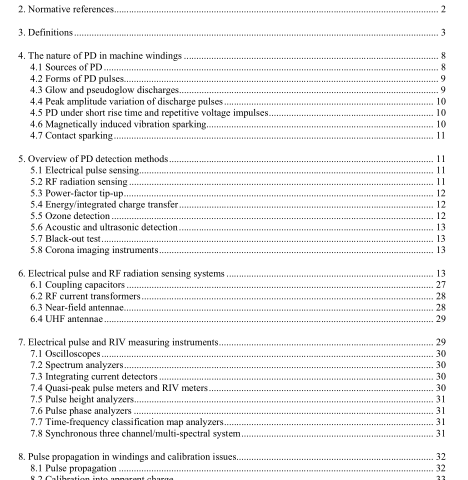IEEE 1434-2014 pdf download.IEEE Guide for the Measurement of Partial Discharges in AC Electric Machinery
contact sparking: Contact sparking comprises two components. One arises due to the cyclic vibration that interrupts the capacitive charging and discharging currents as the external surfaces of the vibrating bars make and break contact with the slot walls.
The second effect, which is not included in the definition, is that of electrostatic induced sparking that occurs when two dissimilar materials with different work functions make and break contact.
NOTE—See Bartnikas and Morin [B3].
9 continuous partial discharges: Discharges that recur at regular intervals, for example, on approximately every cycle of an alternating voltage.
conventional partial discharge detector: The partial discharge (PD) pulses are amplified by a vertical deflection amplifier of an oscilloscope having a bandwidth from approximately 10 kHz to several hundred thousand hertz, and they are displayed on a digital oscilloscope. The height of the vertical deflection can be related to the discharge magnitude. corona: Visible partial discharges (PDs) in gases adjacent to a conductor.
cross-coupling: Energy appearing in one circuit as a result of coupling from another circuit. dissipation factor (tanδ): The tangent of the loss angle δ or the cotangent of the phase angle θ. For values less than 0.1, power factor and dissipation factor are essentially equal.
dissipation-factor tip-up (Δtanδ): The difference in the dissipation-factor measured at two designated voltages.
See also: power-factor tip-up.
electromagnetic radiation: Emission of energy in the form of electromagnetic waves.
high frequency (HF): 3 MHz to 30 MHz. high-intensity slot discharge: Discharges that recur on a random basis involving a large surface of a coil or bar, separated from the grounded steel core by an air gap. Thus, these discharges involve a substantial amount of energy.
NOTE—See Lonseth and Mulhall [B8]. ionization: The process by which electrons are lost from or transferred to neutral molecules or atoms to form positively or negatively charged particles. largest repeatedly occurring PD magnitude (Q m ): The magnitude recording by a measuring system which has the pulse train response in accordance with 4.3.3 of IEC 60270, or the magnitude associated with a pulse repetition rate of a specified number of pulses per second, which can be directly inferred from a pulse magnitude distribution. A recommended pulse repetition rate is 10 pulses per second.
low frequency (LF): 30 kHz ≤ f 1 ≤ 100 kHz; f 2 ≤ 500 kHz; 100 kHz ≤ Δf ≤ 400 kHz where f 1 and f 2 are the lower and upper limit frequencies and Δf is the bandwidth f 2 – f 1 . [IEC 60270 wide-band.]
magnetically induced vibration sparking (vibration spark erosion): On non-globally VPI’d machines, significant magnetically induced current may flow in the semi-conducting coating of a stator coil or bar if the resistance of the coating allows sufficient current flow, and the coil or bar is moving in the slot. In the presence of vibration the current may be interrupted, resulting in sparking and erosion of the groundwall insulation. This may occur at any bar or coil between line and neutral.
noise: Unwanted disturbances superimposed on a useful signal that tend to obscure the signal’s information
content. normalization: A process by which measurements are compared with a common reference.
normalization capacitor: A capacitor through which charge is injected into a partial discharge (PD) measuring circuit for the purpose of normalizing the measurement.
normalized quantity number (NQN): Originally defined as the normalized area under a straight line fitted to the pulse counts in each magnitude window of a pulse height analysis, in which the pulse counts are expressed as a logarithm of the pulses per second and the pulse magnitude window is a linear scale.
The use of the logarithm of the pulse counts in the formula for calculating NQN rather than the use of the actual pulse counts reduces the relative contribution of high repetition rate pulses to the NQN compared with that of low repetition rate pulses. Both the pulse magnitude and repetition rate scales are normalized, and the quantity obtained is divided by the gain of the partial discharge detector.IEEE 1434 pdf download.IEEE 1434-2014 pdf download
IEEE 1434-2014 pdf download

Leave a Reply